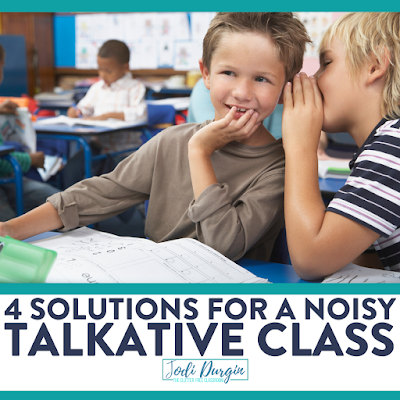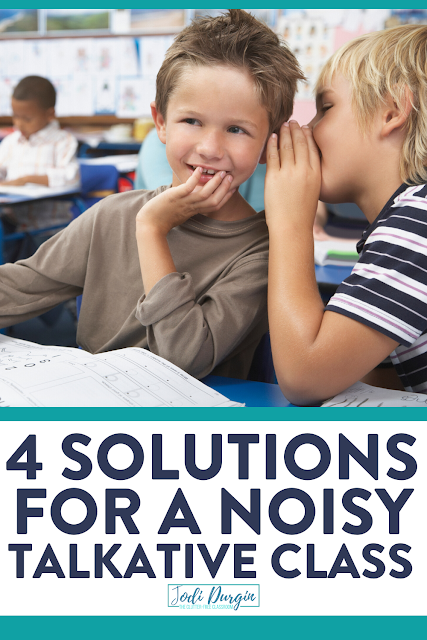Now, there is a difference between a class that is chatty and a class that has academic conversations going. Both may sound similar to an outsider, but the effects it has inside the classroom can be very different. If you have a class of chatty kids who want to talk non-stop, or just that one child who loves to shout out over everyone during your lessons, it can be very stressful (for both you as the teacher and your students). This creates an atmosphere that no one wants to be a part of.
A classroom where students are free to talk whenever they want about whatever they want can have many repercussions including a decrease in learning. This is not something any of us want, but unfortunately is happening all across the country. As a teacher, you want to show that you have control over your students in your classroom, that they can be respectful individuals, and that learning is happening inside. Here are some ways to make sure your class has positive academic conversations going on and not just uncontrollable non-stop chit chat.
This blog post will...
- offer 4 general solutions for a noisy, talkative class
- recommend specific strategies that you can implement today
- suggest a resource that is packed with tips and ideas to help you master classroom management
Attention Getters
- Clapping Rhythm: We all know this one and we all have probably used it at some point in our teacher lives. You notice that the volume in the class is getting a bit too loud, or you need to get everyone’s attention to give them new directions, so you empty your hands and clap a rhythmic beat that kids mimic. Since this strategy is pretty universal, it’s quick to pick up (both for you and the kids), and it’s something they can get used to easily. After the clapping is done, kids are quiet and you can say what you need to.
- Call-Backs: I find these to be the most fun. You say a word or two and the students respond to you with a phrase before being quiet and listening to what you need to say. Examples include: “1, 2, 3, eyes on me…..1, 2, eyes on you!”, “Hocus Pocus!...Everybody Focus!”....or “Peanut Butter!....Jelly Time!”. There are hundreds of these to use and can be found on websites like Pinterest. You’re sure to find one that fits your classroom atmosphere and your personality comfort level.
- Give Me 5: This strategy works with just your hand and no speaking (aside from saying “give me 5”). Children see your hand in the air as you slowly count down from 5 to 0. At 5, they listen, at 4, they empty their hands, at 3, they need to be still, at 2, they need to be quiet, and by 1 they need to have their eyes on the speaker ready to go. The best time to use this strategy is during a transition when kids tend to talk the most.
- Music: Need kids to quiet down and transition to something else? Play a song! Teach kids the procedures that go along with the song and the expectation that by the time the song is over they are in their seats and ready to move on.
- Instruments: My friend used a wooden frog with ripples on its back and a wooden stick that ran up the back to get students’ attention (it made an interesting sound for sure). I’ve also seen bells, tambourines, maracas, and chimes used before. All of these allow you to save your voice too which is a big benefit. Just make sure you keep the item close to you, so you don’t have to run up front quickly to get students to quiet down.
Prevent/Control the Noise
- Traffic Light: In previous years, I had a poster and a working traffic light displayed in my room. The poster said “keep on track with your chat” and explained what each color meant. If the activity was a silent activity, I turned the traffic light to red. If the students were allowed to whisper, the light would be yellow. If the light was green, students could use their regular inside voices while working. It helped kids see a visual of what volume was expected.
- Apps and Noise Control Sites: I love the websites and apps that display things like bouncy balls and move based on the amount of noise in the classroom! Kids turn it into almost a competition to see if they can complete their work without any of the pictures moving.
- Never Talk Over Students: Although it may seem like the best thing to do is to ignore it when a student shouts out or starts a conversation while you're teaching, it can actually signal to the students that it’s ok to not listen to you and what you’re saying isn’t important. When a student starts talking while you’re speaking, calmly stop talking (mid-sentence has a great effect), and stare at the student. Don’t change your body posture though or make sarcastic or frustrated sounds because this can have a negative effect of its own. Wait at least three seconds after the child has stopped talking (don’t break eye contact), and continue with your lesson/speaking.
- Pay Me Now or Pay Me Later: If you expect transitions to be quiet (such as when they put away binders and pull out a book), then you must practice the transition over and over again with it quiet. Even if one student talks, you have to stop everyone and try it all again. They’ll eventually get frustrated with having to repeat the same thing over and over again that they’ll catch on and realize they shouldn’t be making a sound while doing the transition (or task). You may feel that it wastes a lot of time in the beginning of the year to teach these kinds of procedures, but if you master it all in the beginning, you won’t be paying for it all year long.
- Bubble Mouth: The hallway is an area where students at my school are required to be silent. I have them “catch a bubble” in their mouth which means they blow up their cheeks and close their lips as if they have a bubble in there. I’ve also seen kids in the lower grades put their pointer finger over their mouth as they walk (the universal quiet symbol).
Academic Conversations
- Class Discussions: This will take some practice and a good classroom environment where kids feel safe. I once visited the Ron Clark Academy and was amazed to see students who would stand up to share their thoughts without raising their hand and without interrupting anyone. It showed that student input was valued and that students respected each other enough to not interrupt one another. I’m not saying you need to allow your students to get up and stand on a chair to share their thoughts whenever they want, but the idea behind students sharing their thoughts in a polite way that contributes to the conversation is a great one. Students feel they have a voice and a place in the discussion without fear of being ridiculed or wrong.
- Partner Talk: How many times have you gone to a professional development training and in the middle of the presenter speaking, you turned to tell your coworker something about what was just said? I can think of countless times I’ve done this! I see it all the time with adults, so why are we not realizing that kids need to do the same? Kids need to process what is being taught and they have responses or questions about what they’re learning. We need to provide ample opportunities for them to share their thoughts with a partner after pieces of information are given. Provide sentence stems for how they’re supposed to talk to their partner, monitor as they’re all speaking, and give only a short amount of time for discussion in between (30 seconds to 1 minute is plenty).
- Collaboration: Your students have great ideas that are just bursting to come out of them and you should provide plenty of time for them to converse with a group of people about those ideas. Whether it’s a team building exercise to get to know their classmates at the beginning of the year or when they move to a new seat, or during a group project, it’s crucial that kids get their time to discuss ideas with their peers. This time will teach them many social skills and teamwork that are absolutely necessary in today’s world.
- If You Can’t Beat ‘Em, Join ‘Em: Last year, I had a chatty group of kids (it seems like every year they get chattier). In the morning, they wanted to come in and socialize instead of following their morning procedure and bell work and it frustrated me daily. I did research on “how to get kids to stop talking” or “how to get kids to move faster in the classroom” because I felt like that morning time was being wasted. This year, I’ve decided to use that chattiness to my advantage. I can’t get them to come in and work silently on a reading passage and expect great results, so I’ll be using some bell work cards that will challenge them academically and collaboratively. Each group will choose a card from the basket in the morning and TALK to each other about their answers. After the time is up, each group will share their response with their classmates. This gives my kids time to talk (which they do), but it gives the control back to me because I’m providing opportunities for academic conversations. The cards include creating their own math word problems with given names and numbers, hypothetical questions that reveal character traits, lists of materials and they decide what they can build with it, etc. I’m hoping it has the desired effect I want with kids using their voices for a greater good.
Utilize Proven Resources
One important thing to remember is that you’re not alone. We have all had classes that challenged us because of their chattiness and we’ve all googled ways to fix it (or Pinterest). If you try something and it doesn’t work right away, that’s ok, just keep trying! There are many ideas out there that will help you keep a manageable class of kids who just bubble with excitement and want to share their thoughts with you (and their classmates). If you need additional strategies and resources to help you better manage your classroom, I encourage you to check out this classroom management guide. It has everything you need to have a streamlined and focused classroom! I hope you found these ideas and suggestions to be helpful as you prepare to conquer another year in the classroom!


